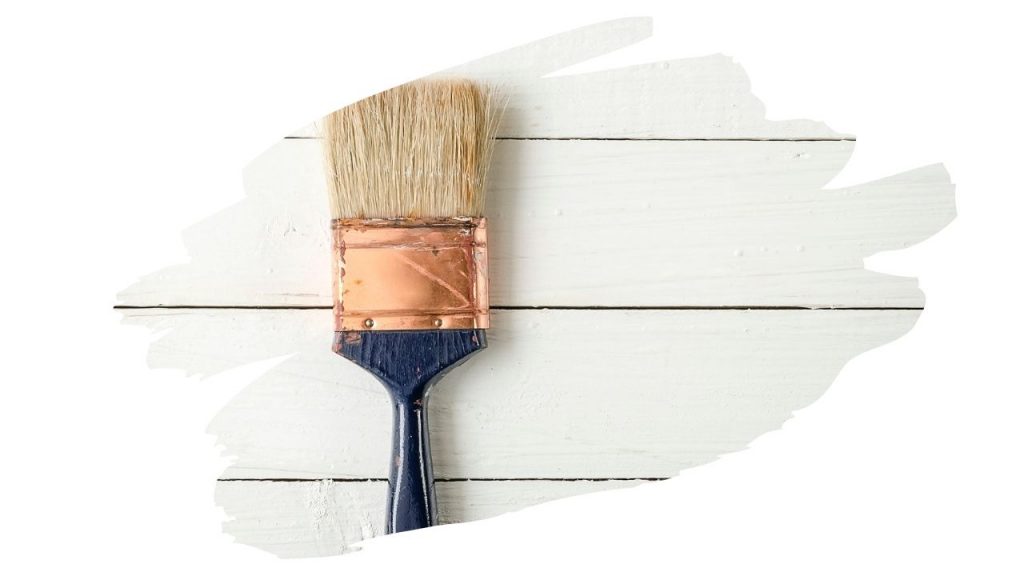It’s important to fix and fill up any cracks, holes, dents, or other damage to wood before painting it.
But now that you’ve painted your woodwork piece you notice you have a problem. It appears as though that wood filler is very visible even after you painted over it.
However, all is not lost. Fixing things when that wood filler starts showing through that paint job is pretty straightforward:
A. Sand Off The Paint
This may take a little while, but if you want your project to look like it was made well then this is what you need to do. You only have to sand about a 1 or 2 inch diameter around the specific spots where the filler is showing up through the paint.
B. Prime The Wood Filler
After you remove the paint, add a coat of primer to seal the filler. For a smoother finish, use a small brush for those tight areas.
C. Repaint Over The Primed Wood Filler
Make sure the primer has dried before painting over the area. Allow at least an hour for the primer to dry. It may take a little longer in colder weather climates.
Now, wood filler marks can be a real pain in the you-know-what. So the only way to avoid having wood filler issues in the future is with a little bit of proper prep work.
So, keep reading to find out the steps you’ll need to take to make sure your filler job is always perfect…

This post may contain affiliate links to products that we receive a commission for (at no additional cost to you). Learn more here.
So, Why Did My Wood Filler Show Through Paint Anyway?
Ah, good old Wood filler. It’s that magical substance that fixes everything and helps to prevent anyone from ever using the term “I suck at woodworking.”
But, wood filler is a pretty poor mimic of wood. For example, it absorbs paint at a different rate than wood. Which essentially means that when you paint over that wood filler, the paint will stick in some areas and not others. This is why we always prepare the surface of lumber first by using a primer (sometimes referred to as an undercoat).
You see, great paint jobs begin with a great primer. And while it might not look as beautiful as a typical coat of paint, primer ensures better adhesion of paint to wood filler, increases paint durability, and can provide additional protection for the material being painted on.
Can I Paint Straight Onto Filler? You could, but only if you want to make a mess. Painting directly over filler will leave you with patchy areas across the surface. A thin undercoat of primer will help those coats of paint adhere better.
Do You Really Need To Seal Filler Before Painting?
Sealing filler is the most effective way to guarantee a gorgeous finish on your woodwork. Some fillers will need to be sanded first before you begin sealing. However, once you do, your finishing job will be much easier.
So, What Is The Best Paintable Wood Filler On The Market?
At the end of the day, wood fillers are simply a synthetic material that tries to mimic wood. And we use it to repair cracks and holes, as well as hide imperfections in furniture, doors, floors and other wood surfaces.
So, the best wood filler? We’re not going to say that there’s a particular “best” wood filler. There are lots of good wood fillers out there, and there are some things that you might like about them that other wood fillers don’t have.
But the most important thing to worry yourself with is if that wood filler is solvent-based or water-based. Why? Well, solvent-based wood fillers can handle the humidity shifts of outdoor weather a lot better than water-based wood fillers can.
And while water-based fillers can usually dry faster than their solvent counterparts, water-based fillers are better suited for indoor projects.
In other words, solvent-based wood fillers – such as Minwax Stainable Wood Filler – can be used for both exterior and interior woodwork jobs.
On the other hand water-based fillers – such as Elmer’s Carpenter’s Interior Wood Filler – should ideally be used for interior jobs.
Okay, So How Do You Use Wood Filler Before Painting?
First off, the main key is to take your time. An hour isn’t a hard deadline. By now you probably know that it’s more important to have fun than to finish that project quickly.
So, take a deep breath and be patient with yourself before you get started on these next five steps:
STEP 1: Prepare The Surface Of The Wood
Prepare the surface to which you are going to apply wood filler by removing dust, debris (swipe with a damp cloth or use a shop vac), and sanding it smooth.
STEP 2: Reapply Wood Filler (If Necessary)
Use a putty application tool to fill in crevices or places where wood may still be cracked. Make sure you over stuff those gaps too, as when wood filler dries it starts to contract and shrink. And once done, use your putty tool to smooth down and even out the surface.
Afterwards, allow the wood filler to dry completely. Now, depending on the brand, this can take as little as 15 minutes. But, typically a wait of anywhere between 2 hours to 6 hours is pretty normal (especially if filling in deeper holes).
It’ll be dry in no time. Don’t rush it.
STEP 3: Sand Down The Wood Filler
Use light pressure to sand over the wood filler sections with fine-grit sandpaper to blend the repair into the surrounding material. Afterwards, swipe a finger over the patched area. Both the wood filler area and the surrounding wood should be virtually even with one another.
STEP 4: Prime That Wood Filler
Next up, you need to seal the filler with primer. Primer is used for sealing the surface of the wood in order to ensure that your paint will stick. Any good all-purpose primer – such as Rust-Oleum Zinsser Bulls Eye 1-2-3 Primer – will do in a pinch.
STEP 5: Repaint Over The Wood Filler
Once you’re satisfied that the primer coat is dry, you can go ahead and reapply your favorite coat of paint.
So To Sum Up
Remember, a paint job is only as good as the prep work that went before. So, ideally, you want to make sure you always seal that wood filler in with a primer before you begin to paint.
But, if you forgot to add that primer coat, then don’t despair. There’s no need to worry if you didn’t brush on a primer layer before your paint job. Just follow the simple steps outlined above and you will soon cover up that unsightly filler.
Good Luck!





